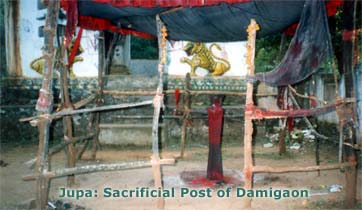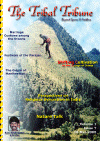Shifting Cultivation by the Juangs of Orissa
The Kondh (pronounced locally as Kandha and spelt earlier as Khond, Kond, etc) are a population of primitive tribe of Orissa. They include subdivisions like Desia (more Hinduized section), Kutia, Dongria (hill dwelling) and Pengo. They occupy mountainous areas of Central-Southern part of the state. The Desia name is assumed by those who live in the plateau, in the neighborhood of non-tribal people who improved their economy and living condition. The Pengo section is also good cultivator and more exposed to the outer world. The Kutia and Dongria occupy the highland; practiced shifting or hill slope cultivation in primitive method and live in poor condition. The habitat of Kondh people is locally known as Kondhamal, meaning hills of the Kondh. Inspite of their rich cultural heritage and valiant nature, they earned notoriety in colonial records due to their ritual of human sacrifice, known as 'meria'. To the people of Kondh community, meria sacrifice is just one of many rituals for better fortune, where animal sacrifice is essential. The practice of human sacrifice came under Prohibition Act of 1829, under the rule of the Governor General of British India, Lord William Bentinck (1828-35) who also stopped the cruel practice of 'sati' or burning Hindu Widow on funeral pyre. But in reality such sacrifices went on for many more years in inaccessible villages. Later on human-beings were replaced by monkeys and subsequently by buffaloes. The Kondhs attracted the attention of many British Administrators and anthropologists. Many books and reports are available since nineteenth century. Western Scholars like Verrier Elwin, F G Baily, Barbara Boal and Herman Niggemeyer deserve mention, noted anthropologist Dr N Patnaik, produced a comprehensive book on the Kondh in the last quarter of 20th century. Since then, lot of changes have occurred in the habits and habitat of the Kondh people. The present appraisal will present a picture of such sacrificial rituals as now practised by the Kondh people. Data have been collected by personal association with the performers. An inquisitive scholar may be able to make diachronic analysis after going through earlier literatures. The Kondh society in religious matters, is guided by several categories of priests:
1. Jani, 2. Matiguru, 3. Dehuri, 4. Bahuk and 5. Jhankar. They perform specific duties for specific rituals. The present information was collected from such priests from four villages with a large command area. They are:
Like most other tribals, the Kondh are Nature worshippers. The mountain, the river, the Sun, the Earth, all have presiding deities, who need to be propitiated. The Priests follow the age-old traditions. Seven such rituals are here identified: 1. Jhagadi or Kedu or Meria Puja, 2. Sru Penu Puja, 3. Dharni Penu Puja, 4. Guruba Penu Puja, 5. Turki Penu Puja, 6. Pitabali Puja and 7. Khambeswari and Maheswari Puja. 1. Human Sacrificial ritual of earlier time (Meria): This Jhagadi or Kedu has originated from the belief that mother Earth should be appeased for welfare of the villagers, or community, not of an individual. In olden days, the Kondhs settled the boundary of their village and wanted the earth goddess of that area to keep their residents in good fortune. In case, some serious misfortunes occurred, they consulted the 'Matiguru' (priest in-charge-of Earth Goddess or 'Dharani'). He considered the case with his divine process and prescribed the right type of worship like 'Dharani Puja', 'Guruba Puja', 'Turki Puja' or the most serious 'Meria Puja. Accordingly, the village head and his council, confided in a non-tribal 'Pano' (a scheduled caste) person to collect a suitable young person for becoming 'Meria'. [The Pano community live in some villages in commensal relationship with the Kondh. it is said that the Kondh is the king and Pano is minister i.e. advisor.] Thus empowered, the Pano men procured a suitable sacrificial human individual (normally a young male, sometimes a female also) by kidnapping or duping. [Some informants claim that male Meria was alternated with a female Meria in next occasion.] The person thus procured was kept in secrecy and the priest started preparations for the worship. The 'Meria' to-be was well cared for by the villagers till the fateful moment. The worship rituals took two days, involving all the priest groups headed by the 'Matiguru'. The 'Baredi' or the site cleaned worshiped with a he-goat sacrifice and a wooden (of 'Rohini' wood) post (Jjupa) was erected. The next date, the 'Meria' person was ritually cleaned with turmeric paste, oil and bathed. The person was well decorated with 'Kajal' (collyrium) on the eyes, vermilion on forehead and garlands on the head, neck and arms, and was taken round the village, to show the boundary. On the way the villagers fed him in gratitude, because after death, the soul will guard the boundary as a spirit 'Bhuany'. The 'Meria' was made intoxicated with liquor, so also the people.
After forceful stoppage of this horrific sacrifice, the ritual was completed with monkey (nearer to man) sacrifice. When that was discouraged, they started sacrificing buffalo. There is no fixed time for performance, as it depends on the prescription. 'Jhagedi' or 'Kedu': This is the present form of the 'Meria' worship of Earth Goddess. The decision to observe, the priest involvement rituals and purpose are the same. A Pano person buys a sacrificial buffalo, for which there is no secrecy. The place is not the same 'Baredi' and the spirit of the buffalo is not 'Bhuany' but 'Gogiani', who delivers benefit. In this case Jani beheads the animal and buries there.
This worship is performed at the foot of a fixed mountain or hill at a fixed place. The things required for this are 1.sundried rice in new bamboo made pan, 2.termeric, 3.winnowing fan, 4.ladle of ground skin (lau tumba), 5.shorea pobusta (shal) leaves and siali leaves, 6.incense, 7.wine, 8.fowl and he-goat. In this Puja chief is the 'Dehuri'. He does the ritual performance being assisted by Jani, Jhankar and Bahuk.
This is the first Puja of the year for the Kondh community. After 'Saru Penu' Puja they eat new fruits, corn and vegetables produced. Other Pujas cannot be celebrated until the Puja is done. This is special feature of 'Saru Penu' Puja. They believe that if sarupenu is pleased their life and property will be safe, against wild beast of prey and total development of the village is feasible. Like 'Saru Penu' Puja, 'Dharani Penu Puja' is also observed for two days. All the paraphernalia are held on the previous day to invite Dharani Penu. Maintaining all due purity and austerity all the village people including all Dehuri, Jani, Jhankar and Bahuk go to the fixed place meant for observance outside of the village location. They drink wine and play upon drums, pipes etc. Dehury mainly does all the ritual activities in the presence of all. Things utilised here are 'sal' leaves, 'siali' leaves, sundried rice, turmeric, country wine and sacrificed foul and he-goat. After Dehury's chanting of mantra and offering of things to the deity, Bahuk sacrifices the foul and he-goat. The blood of the animal is offered to the deity. After Puja, They make feast and drink. The aim of the worship is to please the Earth Goddess for the safety of the village. This Puja is generally observed outside the village, in a fixed place meant for it. As per the description mentioned in the previous Puja, the deity is invited on previous day. The things required for the actual Puja are 'sal' leaves, 'siali' leaves, sundried rice, turmeric, and fowl instead of he-goat. They beat drums and blew trumpet. All drink liquor. Dehury performs Puja chanting mantras. Bahuk sacrifices the fowl. Blood is offered to please the deity for village welfare and protection. Then they feast, drink country wine and take 'prasad'. Thus the Puja ends. The place is just at the end of the village. The village goddess is symbolized by a big stone buried partly there. There is neither a temple nor a house for the deity. There is no worship for the goddess every year. After 'Kedu' or 'Jhagadi', generally ' Turky Penu Puja ' is performed by the Matiguru offering the needful articles such as 'siali' leaves, sundried rice, turmeric, wine and pig. People sound drums, changus and blow trumpets. He worships to appease the village deity with offering and mantra. Finally he sacrifices the pig and offers blood. After Puja the village people feast and drink. The deity has a temple or place in house outside the village with boundary walls. In front of the temple or house there is a 'Jupa' or a sacrificial post with 8 metals, which is worshipped with turmeric, vermilion, rice, etc on a copper plate. The idol of goddess is wood. The Dehury keeps the deity in his home. Each day he brings it and place on the sanctum sanctorum and worships per promise individuals or all the villagers worship here. Only one Dehury does all the Puja here. The offerings for the deity are flowers, fruits, sandal paste, incense, ghee-lamps, ghee, sundried rice, turmeric, buffalo or a he-goat and fowl. No wine is used here as offering. Dehury performs all Puja work with mantras. Bahuk does the sacrifices. Blood is offered to the deity to please her for the wellbeing of the village and fulfilling the personal desires. After the Puja they feast and eat. 7. Khambeswari-cum-Maheswari (Sankhudikhai Mangala and Nisankhudikhai Mangala) Puja: Out the village there is a fixed place for Puja of both the goddess either in a temple or house to worship separately. For Khambeswari Puja flowers, sandal paste, incense, lamps and a he-goat are required where as for Maheswari Puja flowers, sandal paste, incense, lamps and for offerings food staff like 'Muans' (fried balls of paddy with jaggery mixed), 'Wookhuda' (fried paddy with jaggery mixed), coconuts and bananas are required. Dehury performs the Puja and Bahuk sacrifices the animals. Blood is offered to Khambeswari to please her for the welfare and safety of the village and for fulfillment of personal aspirations. At the end the villagers feast and enjoy the prasad. The speciality of such Puja is that no wine is offered here. The last two worships of 'Mangala' goddess appears to have been inducted into the Kondh pantheon from the neighboring Hindus. |
||||||||||||||||||
Photographs : Author
References :Some Notable Literature in Kondh:
-
The Kondh of Orissa: N Patnaik and P S Das Patnik, Tribal and Harijan Research and Training Institute, Govt. of Orissa, 1982.
-
Tribe, Caste and Nation: F G Bailey, Oxford University Press, London, 1960.
-
Tribes of Orissa: J K Das, census of State Govt. Publication, and 1981.
- Tribal Myths of Orissa: R Russel, e-printed 1975, Cosmo Publication, Delhi.








